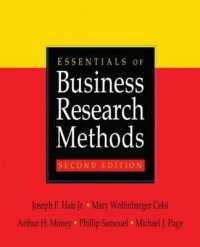Full Description
This Reader aims to help students start reading original Sanskrit literature.
When we study ancient languages, there often is quite a gap between introductory, grammar-based classes and independent reading of original texts. This Reader bridges that gap by offering complete grammar and vocabulary notes for 40 entertaining, thought-provoking or simply beautiful passages from Sanskrit narrative and epic, as well as over 130 subhāṣitas (epigrams).
These readings are complemented by review sections on syntax, word formation and compounding, a 900-word study vocabulary, complete transliterations and literal translations of all readings, as well as supplementary online resources.
The Reader can be used for self-study and in a classroom, both to accompany introductory Sanskrit courses and to succeed them.
Contents
Acknowledgements
Read Me! A Brief Introduction You Won't Want to Miss
How to Do More With Words: Building Up Your Sanskrit Vocabulary
Beginning to Read Sanskrit: Some Practical Tips for English Speakers
Annotations and Abbreviations
The Readings
1 Hitopadeśa, or Supportive Advice
a The Dog, the Donkey and the Thief (2.2)
b The Lion, Mouse and Cat (2.3)
c The Clever Woman and the Bell (2.4)
d The Clever Woman with Two Lovers (2.6)
e The Lion and the Old Hare (2.8)
f The Elephant, the Hares and the Moon (3.3)
g The Blue Jackal (3.7)
h The Sage and the Mouse (4.5)
i The Old Crane and the Crab (4.6)
j The Brahmin and the Pots (4.7)
k The Two Demons (4.8)
l The Brahmin and the Three Crooks (4.9)
2 Vikramacarita, or Vikrama's Deeds
a I Volunteer as Tribute (Story 8)
b Eight Jewels from Eight Goddesses (Story 21)
c King Vikrama in His Element (Story 22)
d Don't Believe Everything You See (Story 30)
3 Rāmāyaṇa, or Rāma's Journey
a The Beauty of the Night (1. 33.14-18)
b A Perfect Leader (2.1.15-28)
c A Land Without Leadership (2.61.8-23)
d Jābāli the Materialist on the Meaning of Life (2.100.1-17)
e Sītā Cautions Rāma on the Handling of Weapons (3.8.1-12, 20-29)
f Rāma Asks Nature If It Has Seen Sītā (3.58.1-22, 31-34)
g The Ascetic Śabarī (3.70.4-27)
h The Hermitage of the Seven Sages (4.13.12-27)
i Tārā Counsels Her Husband Vālin (4.15.7-23)
j Tārā Laments Her Husband Vālin (4. 20.12-17)
k The Rainy Season (4.27.2-46)
l Svayaṃprabhā's Cave (4.49.12-52.13)
m Hanumān Learns about His Immaculate Conception (4.65.8-28)
n How Should I Address Sītā? (5.28.3-44)
4 Kathāsaritsāgara, or Ocean of Rivers of Stories
a Śiva Explains the Significance of Skulls (1.2.10-15)
b Brahmadatta and the Golden Swans (1.3.27-34)
c Pāṇini (1.4.20-25)
d Hand with Five Fingers, Hand with Two Fingers (1.5.8-12)
e Why the Fish Laughed (1.5.14-25)
f King Śibi Sacrifices Himself (1.7.88-97)
g How the Bṛhatkathā Came to Earth (1.8.1-38)
h Ahalyā: Bilingual and Clever (3.3.137-147)
i Buddhist Merchant, Hindu Son (6.1.11-54)
j The Brahmin and the Outcaste (6.1.123-133)
k The Seven Princesses: King Kaliṅgadatta Is Told a Story within a Story within a Story (6.2.9-45)
l Tapodatta Tries to Replace Study with Penance (7.6.13-24)
m Should You Turn a Mouse into a Girl? (10.6.125-135)
n Once You've Tasted the Good Stuff ... (10.6.178-185)
o Guard the Door! (10.6.209-211)
5 Bṛhatkathāślokasaṃgraha, or Verse Summary of the Great Story
6 Subhāṣitas, or Epigrams
Appendix 1: Roman Transliteration of All Texts
Appendix 2: Literal Translations of All Texts
Appendix 3: Study Vocabulary







